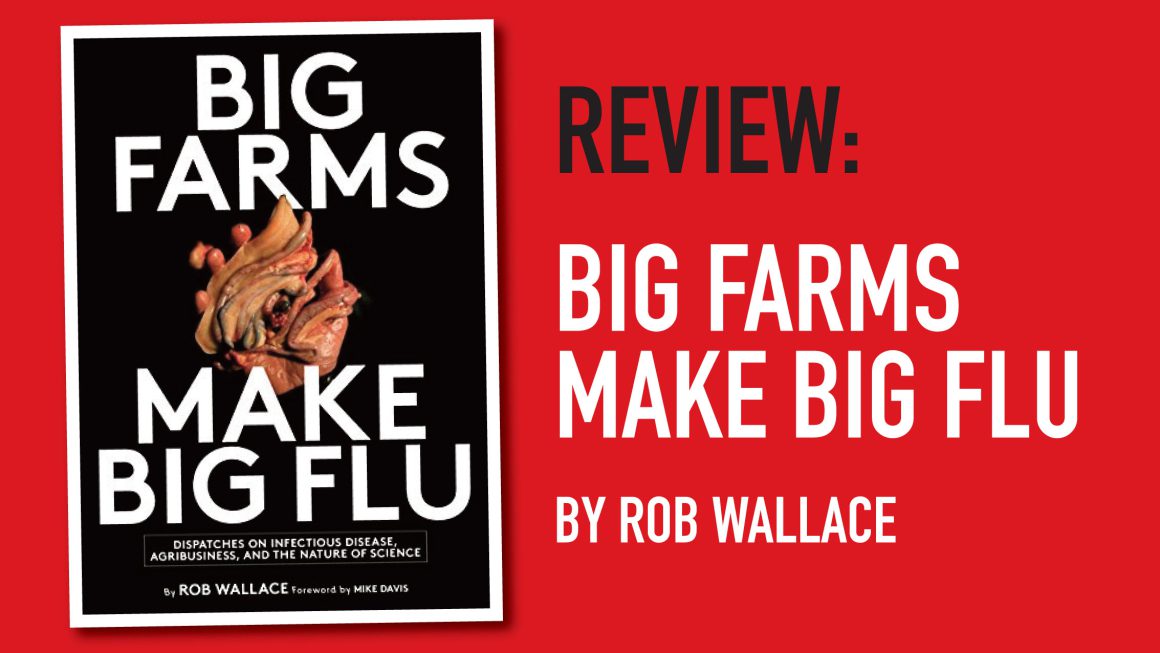By Ben Samson
Covid-19 is spreading across the globe at an alarming pace, overwhelming health infrastructure and killing thousands, many of whom are frontline healthcare workers and poor people who lack early access to testing. Covid-19 is the acute respiratory disease caused by SARS-CoV-2, also known as the coronavirus. Genetically, this virus is 82% similar to the coronavirus responsible for the SARS outbreak in 2003.
Both viruses appear to have transmitted from bats through intermediate animal hosts and into humans in southern China. While western leaders such as Donald Trump are keen to lay blame for the current outbreak squarely at the feet of the Chinese government, the evolution of such viral outbreaks involves considerably more moving parts, the biggest of which can be found in the nature of capitalist farming regimes, and by extension, capitalism itself.
Rob Wallace’s 2016 book, Big Farms Make Big Flu: Dispatches on Infectious Disease, Agribusiness, and the Nature of Science in many ways should have served as a forewarning for the current coronavirus outbreak. Wallace himself is an evolutionary virologist who specialises in mapping the “phylogeographies” of zoonotic viruses, in particular those which cause swine (H1N1) and avian (H5N1) flu (influenza). What this means is that he tries to understand the historical and geographical distributions of these viruses.
Fundamental problems with for-profit science
A key idea that Wallace introduces early on is that for many lineages of zoonotic viruses (viruses which can transmit from animals to humans, such as the coronaviruses), the material variables underlying their evolution and epidemiology are not totally random. Most virologists will tell you that this is an obvious statement, but in their practice, the socioeconomic factors affecting viral spread and evolution are deemed to be just that – random variables!
What this means is that little focus is placed on trying to understand those forces which cause a “low-pathogenic” strain of influenza, that might infect wild geese, to become a “high-pathogenic” strain – capable of infecting and killing millions of humans. Rather, as Wallace makes clear, a bigger emphasis is placed on trying to understand the molecular mechanisms by which such viruses overcome the human immune system. This is, of course, a critical area of study because it leads to the development of effective vaccines. However, it is to the detriment of preventing future outbreaks when the selective forces driving the evolution of viruses are not questioned.
As Wallace explains, one of the reasons that this “molecular approach” to viral pandemics is taken can be found in the type of for-profit science which is practiced by big pharmaceutical companies. For them, there is little money to be made in removing the conditions under which a zoonotic virus might evolve, as no virus means no expensive vaccine from which a profit can be made. In this sense, it is more profitable to service the problem rather than prevent it in the first place – this is the logic of capitalism.
Although for-profit science is completely incapable of dealing with the root causes of viral pandemics, public researchers are also routinely met with roadblocks when they attempt to mathematically model the emergence of zoonotic viruses. For these models to be effective at predicting future outbreaks, they need access to detailed information about the geographical and agroecological origins of different viral strains. In addition, they also need access to samples of the viruses themselves, as their genetic sequence information is used to piece together their evolutionary trajectories across geographical space.
Wallace provides a compilation of recorded incidents in which countries have refused to cooperate with the World Health Organisation (WHO), and even lobbied it to adopt new systems of nomenclature so as to direct attention away from certain governments or industries which may bear some responsibility for an initial outbreak. Governments are certainly inclined to withhold crucial information about local virus outbreaks lest they become the focus of international condemnation. However, their unwillingness to cooperate more so arises because state power has become captured by big agribusiness.
The nefarious role of agribusiness
By way of a case study, Wallace exemplifies the 2009 swine flu outbreak as a pandemic which proved near impossible to trace due to the immense power which global agribusiness wields. The swine flu outbreak, which involved a re-emergence of the H1N1 influenza strain responsible for the Spanish flu outbreak in 1918, originated in Veracruz, Mexico, and quickly spread into the United States. Despite being beyond reasonable doubt that the outbreak originated in a battery stock of swine owned by a Veracruz-based subsidiary of Smithfield Foods Inc., US agricultural officials hypothesised without a shred of evidence that the virus originated from pigs in Asia and was brought to the US by a human. This hypothesis was prompted because the immense wealth and lobbying power of agribusiness is so great that they can both secure permission to self-test and can easily assuage bought state officials that internal testing results are legitimate.
Wallace brilliantly explains how viral pandemics are intrinsic to the capitalist economy itself. The intense modern industrial farming strategies used by the multinational agribusiness sector seeks to maximise profit from the brutal exploitation and barbaric treatment of animals. In the case of industrial poultry, genetically uniform broiler chickens have been selectively bred to grow three times as fast on half the amount of feed as their wild relatives. This “productivity” comes at the cost of a robust immune system.
On top of this, the enclosed shed systems employed by industrial growers prevent exposure to the low-pathogenic viruses that naturally circulate through populations of free-ranging poultry reared by smallholder farmers. Since their immune systems are not regularly primed by these low-pathogenic strains, on the odd – and inevitable – occasion that such strains do enter battery populations, they quickly evolve to become highly pathogenic and virulent.
The likelihood of broiler populations contracting low-pathogenic strains increases as climate change and deforestation forces wild bird populations into closer proximity with industrial farms. While agribusinesses are expected to test their birds and adopt costly biosecurity systems, the constant pursuit of short-term profit inherently favours those who don’t. In any case, the costs of culling infected birds are borne by the state, whereas the loss of profits are borne by the growers who are only contracted by the agribusiness companies to raise the birds, which the companies also own.
Moreover, in the case of outsourcing production to the “global south”, IMF-imposed structural adjustment programmes combined with governments beholden to foreign direct investment (FDI) create a highly repressed and agribusiness-dependent labour force, which grows patented bird stock in the backdrop of poor domestic animal and public health infrastructure. It is therefore very clear that the interests of capitalism and the preventative measures needed to prevent viral pandemics are largely incompatible.
Standard models: Missing the wood for the trees
Wallace makes it soberingly clear that the globalised network of livestock production not only potentiates viral pandemics, but actually acts as a selective force which inextricably determines viral evolution. If epidemiological models were to incorporate those factors which determine the rate of spread of intensive industrial farming methods, deforestation and the loss of biodiversity, their predictive power would undoubtedly be massively boosted.
What would be revealed by such models is that a hypothetical future outbreak is unlikely to originate in a south Chinese province when an exhausted, immunosuppressed migrant worker forgets to spray down a feed truck, but rather is traceable back along flows of capital to cities like Hong Kong, London and New York. It is these locations which are the true ground zeroes in which pandemics are initiated. For instance, the 2009 swine flu pandemic originated in Mexico, but only because the North American Free Trade Agreement (NAFTA) paved the way for US-based agribusiness to relocate their production there. In applying this structural analysis, Wallace wryly proposes that the swine flu be renamed the “NAFTA flu”, because the pandemic was initiated when capital based in North America successfully passed NAFTA.
Although this type of modelling might suggest that neoliberalism is the root cause of viral pandemics, it is more accurate to say – as Wallace repeatedly does – that capitalism itself is the driving force. By the nature in which accumulated capital captures state power, agribusiness is not really disciplined by free market economics, but rather it uses the state to eviscerate workers’ rights, insure against economic recessions and imperially acquire new markets and repressible pools of labour. On this point, Wallace even praises the prescience of Lenin’s 1917 writings on “American regionalism” in the context of US agriculture.
An alternative to industrial farming
Towards the end of the book Wallace dismisses both Malthusianism (seeing large populations as the fundamental problem) and Misanthropy (seeing human beings as the fundamental problem) in the same breath, as both tend towards favouring the capitalist class at the expense of the working class. This is important, as fringe environmental groups sometimes, even inadvertently, prescribe ecofascist ideas when they suggest that viral pandemics serve as important population controls. Instead, Wallace believes that food and disease science should be used to better inform planning so as to avert disease outbreaks while still sustaining a sufficient level of productivity.
Using a number of peer-reviewed studies, Wallace also illustrates how certain ecosystems which possess complex webs of mutualisms are much more robust and resilient to disease outbreaks. These natural systems are fine-tuned over relatively short geological time periods, but over long periods of anthropogenic (human) time. By contrast, intensive capital farming regimes have sprung up over very short periods of anthropogenic (human) time. This short timescale gives little time for ecosystems to adapt, but is more than long enough for the evolution of zoonotic viruses because of their higher rates of molecular evolution, which are made possible due their short life-cycles.
Wallace proffers the ideas of dialectical biologists such as Richard Levins and Richard Lewontin. Levins, who spent time as a scientific adviser to the Cuban government and collaborated for most of his career with its scientists, advocates devolving production into local but centrally administered networks of well-regulated farms, organised along a “planned mosaic of land uses” so as to utilise pre-existing local ecologies. It also becomes essential to maintain local microenvironments and topologies, whilst preserving and restoring natural banks of genetic diversity. As Wallace describes, when biodiversity is lost, the chances of an otherwise harmless virus mutating and spreading into livestock and even human populations significantly increases.
A powerful argument for socialist change
In the end, Wallace has done an excellent job in demonstrating how the evolution of highly pathogenic and virulent viruses was rapidly accelerated following the globalisation of intensive capitalist farming regimes. Even now, decisions taken in the interests of capital accumulation determine future viral pandemics. By incorporating trajectories of capital flow into infectious disease models it becomes easier to better predict future viral outbreaks. Such modelling would most certainly have better predicted the current Covid-19 pandemic. Ultimately, what this indicates is that capitalism itself is the problem. However, it is not necessary to wait on the results of complex modelling for us to organise to break away from capitalism in the direction of a socialist society, as a matter of urgency. This urgency comes not only from the inherent animal cruelty involved in capitalist farming methods or the clear effects these methods have on the evolution of zoonotic viruses, but also from the untold exploitation of workers at every stage of production, particularly in the global south.
In explaining how capitalist farming regimes replicate worker exploitation across the globe in much the same way as they replicate zoonotic viruses, Wallace highlights the importance of both geographic Marxists such as David Harvey, who he regularly cites, and the more orthodox Marxists who focus on labour exploitation. Empowering workers in their struggles against cruel agribusiness employers will be essential to topple capitalist forms of power as they geographically consolidate themselves. In this sense, workers’ struggle against capitalism becomes a vital tool in the fight against viral pandemics in more ways than one.












